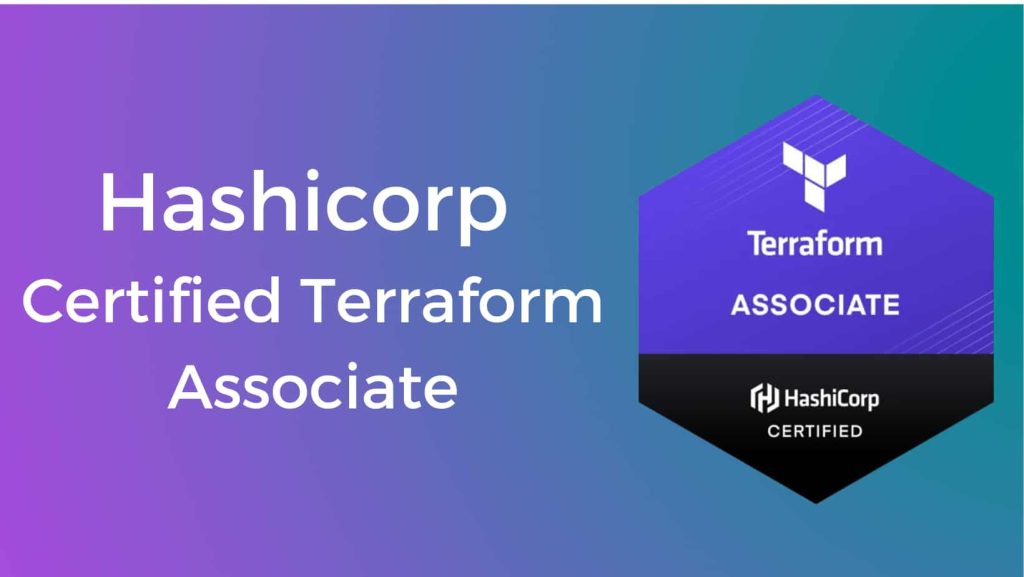HashiCorp Certified Terraform Associate
Terraform Associate Certification is for Cloud Engineers who work in IT, operations, or developers familiar with the fundamental principles and skills of HashiCorp Terraform.
New Batch Starting In

Target audience
- Cloud engineer
- DevOps professionals
- System administrators
- Developers
- IT managers
Benefits of obtaining the Terraform Certified Associate certification
Enhanced credibility: The certification demonstrates your proficiency in Terraform infrastructure as code and validates your skills and knowledge in the industry.
Career advancement: The certification can enhance your career prospects and open up new job opportunities, such as cloud engineer, DevOps engineer, infrastructure engineer, or IT manager.
Improved salary: Certified professionals are often able to command higher salaries due to their specialized skills and expertise.
Better job performance: The certification equips you with the knowledge and skills to optimize infrastructure management and automate tasks, leading to improved job performance.
Access to a community of experts: Certified professionals can join a community of experts and collaborate with like-minded professionals, which can provide opportunities for professional growth and development.
Recognition by employers: The certification is recognized by leading employers and can increase your chances of being hired or promoted within your organization.
Exam Overview
Certificate Name
HashiCorp Certified Terrraform Associate
Exam Format
Multiple choice
Passing Score
70% or Above
Certificate Exam Code
002
No of Questions
57 -60
Exam Duration
120 Minutes
Exam Fee
$71 USD
Exam Languages
English
Validity
2 years
Course Curriculum
- Explain what IaC is
- Describe advantages of IaC patterns
- Explain multi-cloud and provider-agnostic benefits
- Explain the benefits of state
- Handle Terraform and provider installation and versioning
- Describe plugin-based architecture
- Demonstrate using multiple providers
- Describe how Terraform finds and fetches provide
- Explain when to use and not use provisioners and when to use local-exec or remote-exec
- Given a scenario: choose when to use terraform fmt to format code
- Given a scenario: choose when to use terraform taint to taint Terraform resources
- Given a scenario: choose when to use terraform import to import existing infrastructure into your Terraform state
- Given a scenario: choose when to use terraform workspace to create workspaces
- Given a scenario: choose when to use terraform state to view Terraform state
- Given a scenario: choose when to enable verbose logging and what the outcome/value is
- Contrast module source
options - Interact with module
inputs and outputs - Describe variable scope
within modules/child modules - Discover modules from the
public Terraform Module Registry - Defining module version
- Describe Terraform workflow ( Write -> Plan -> Create )
- Initialize a Terraform working directory (terraform init)
- Validate a Terraform configuration (terraform validate)
- Generate and review an execution plan for Terraform (terraform plan)
- Execute changes to infrastructure with Terraform (terraform apply)
- Destroy Terraform managed infrastructure (terraform destroy)
- Describe the default local backend
- Outline state locking
- Handle backend authentication methods
- Describe remote state storage mechanisms and supported standard backends
- Describe the effect of Terraform refresh on state
- Describe backend block and cloud integration in configuration
- Understand secret management in state files
- Demonstrate use of variables and outputs
- Describe secure secret injection best practice
- Understand the use of collection and structural types
- Create and differentiate resource and data configuration
- Use resource addressing and resource parameters to connect resources together
- Use Terraform built-in functions to write configuration
- Configure resource using a dynamic block
- Describe built-in dependency management (order of execution based)
- Describe the benefits of Sentinel, registry, and workspaces
- Differentiate OSS and TFE workspaces
- Summarize features of Terraform Cloud
